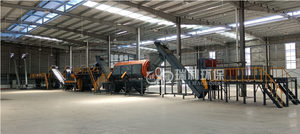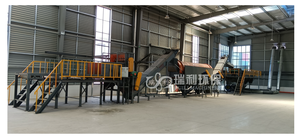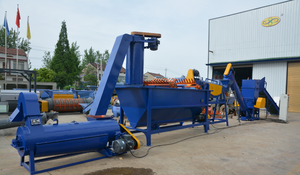
All categories
Featured selections
Trade Assurance
Buyer Central
Help Center
Get the app
Become a supplier

(1374 products available)




















A PET bottles washer is a machine that cleans and removes any kind of dirt or grime after the bottles have been shredded into flakes. The cleaning procedure for PET bottles is the most essential and primary step in producing quality flakes. A friction washer is one such step in this cleaning procedure. The main function of a friction washer is to remove the fine residues left on the shreds of plastic bottles.
The main purpose of a pet bottles friction washer is to eliminate the whole contaminants from the bottles, such as labels, stickers, and glue. The friction washers perform the washing through the friction created between the bottles or bottle flakes and the machine's surface. It is usually made up of a cylindrical basket with a perforated surface, a spinning screw, and a drainage system.
Designs of friction washers may vary from the type of recycling plant or area they are being used in. Here are a few washers for friction that are usually used in the recycling process:
Washer and dryer combo
This unit is used as a stand-alone washing device. While using cold and warm water, the machine aims to eliminate such contaminants as labels, stickers, GLUE, etc. Using a PE/PP bushing inside, it further reduces the noise level and effectively cleans the bottles' insides. After the washing process, the same machine can dry the wet plastic using a centrifuge.
Friction Washer with Sink
This combination works as a sink and washer. It's a bath for the plastic to soak and remove the contaminants. A washing sink is usually used when the plastic has more stubborn obstacles, such as hard black spots or heavy dirt inside. A detergent or chemicals are sometimes used to see better results. A washing sink also uses a washer auger like the PE/PP bushing inside to reduce noise and improve cleaning efficiency.
Rotary Washer
This machine is usually used to clean hard black spots or any other heavy external spots on the plastic. It works by scrubbing the plastic with a brush, hence the name Rotary Washer. This machine identifies contaminants that other washing machines cannot eliminate.
All these washers work differently depending on the recycling production line. An important thing to note is that friction washers in the recycling industry do further eliminate other contaminants like GLUE, MAGNETS, COTTON, STICKERS, and many more after further steps in the recycling process.
Body and lid size:
The body of the friction washer is usually cylindrical, with a diameter and height corresponding to PET bottles. Specifications can be matched according to common PET bottle sizes. For example, for 500ml PET bottles, the friction washer might have a body diameter of about 7~8cm and a height of about 10~15cm.
Friction medium:
The inner wall of the friction washer uses materials with different roughness and cleaning capabilities, which will affect the washing effect of the bottles.
Flow rate:
The rate of water flow through the friction washer signifies the number of PET bottles it can process per unit of time. For example, some friction washers can wash up to 200~300 PET bottles in one hour.
Spray nozzles:
Friction washers usually have adjustable spray nozzles to change the size and shape of the water spray to ensure thorough cleaning of the bottles. The number of spray heads, spray types, and positions may vary depending on different models.
Power:
The power of the friction washer signifies the motor power driving the device, which affects the speed at which the friction disc rotates and the cleaning power.
Weight:
The weight of the washer will affect the stability of the device when in use, as well as its portability and ease of movement.
Operating environment:
Friction washers are typically used in damp, bottle-washing workshops and are adaptable to temperature, humidity, and other factors.
Regular cleaning:
Cleaning the friction washer periodically is critical. Use a soft cloth or brush to wipe the surface of the washer to avoid the dirt accumulating and affecting the friction force and cleaning effect.
Replacement of wash solution:
It is necessary to change the cleaning liquid used by the friction washer. After the cleaning liquid is used for a period, its cleaning ability will reduce, and it will have to be replaced to ensure the cleaning quality.
Friction medium inspection:
Friction washers have friction mediums, such as the inner walls of rubber or sand-like materials. These should be checked periodically to ensure that they are not worn or removed.
Pump maintenance:
Friction washers usually have pumps to provide pressurized water. Maintaining the pumps ensures they function correctly. Users should clean the pumps and replace the seals and other parts as needed.
Electrical components:
Users should check and maintain the electrical components of the friction washer periodically, including motors, switches, etc. Users should check the connection and state of the wires, ensuring the electrical components function appropriately.
Lubrication:
Lubrication of some friction wash parts, such as bearings and gears, ensures their smooth operation and stability.
Safety checks:
Users should check the safety of the friction washer periodically, ensuring that the protective covers and safety interlocks are in place for avoiding accidental injuries and ensuring safe use.
PET bottle friction washers are not limited to the recycling industry alone. They find usage in various sectors and applications.
Recycling Plants:
The primary use of a PET bottle friction washer is in recycling plants. Friction washers play a vital role in cleaning contaminated PET bottles, ensuring high-quality production. The washer separates caps, labels, and other contaminants and expertly cleans and sanitizes the crushed bottles.
Pre-treatment for Granular Production:
Frisction washers are crucial for creating granular products from filthy materials. Rubber washers eliminate impurities before introducing them into the extruders, enhancing their efficiency and simplifying the subsequent production steps.
Recycling in Other Bottle Industries:
A bottle washer is not limited to washing PET bottles only but can effectively handle other bottle types too. By incorporating a friction washer into the recycling process, various bottles made from distinct materials can be recycled, thereby reducing waste.
Food and Beverage Industry:
In the food and beverage industry, friction washers can be employed for sanitizing bottles before filling them. They remove residual contaminants, ensuring that the bottles are clean and hygienic for food and beverage companies' operations.
Packaging Industry:
The packaging industry uses PET bottles extensively. Friction washers can be used to clean bottles before they are filled with products. This ensures that the packaging is clean and free from contaminants, preserving the product's integrity.
Sustainable Manufacturing:
Companies prioritizing sustainable manufacturing practices can employ PET bottle friction washers as part of their waste reduction initiatives. By recycling PET bottles within their facilities, they contribute to a circular economy and lessen their environmental impact. This aligns with their commitment to sustainability and responsible manufacturing.
After understanding the benefits and working of a PET bottle friction washer, it is easy to figure out some important factors to consider when buying them for use in a recycling plant.
Production Capacity:
First, the buyer has to know the number of PET bottles friction washers the recycling plant needs to complete its task in the least possible time. The capacity of the friction washers of different brands and models may vary. A friction washer with a larger hopper and drum will be able to process more bottles in one cycle. So, if many bottles need to be processed in a day, then it is better to buy friction washers with larger capacities to meet daily needs.
Features:
Different friction washers have different features and specifications. Buyers have to carefully examine the features of each friction washer, for example, the material it is made of and the type of motor it uses. It is best to buy friction washers that are made from wear-resistant materials. This way, they can have longer lifespans and reduce the cost of frequent maintenance and repairs. Also, a friction washer with a powerful motor can process PET bottles more quickly, removing labels and contaminants more effectively.
Friction Washer Price:
The price of a PET bottle friction washer varies with different brands, models, and specifications. Buyers have to choose a friction washer that fits their budget and offers the features and performance they need. To make a fair comparison, buyers should compare the advantages and disadvantages of different friction washers, not just the price.
After-Sales Service:
It is better to choose friction washers with reliable after-sales service. Good after-sales service means the seller will provide support for repairs or parts exchange when needed. This gives extra peace of mind to the buyer in the long run.
Q1: How efficient is a PET bottle friction washer?
A1: The efficiency of a PET bottle friction washer depends on different factors, including the design, water flow rate, chemical usage, bottle type, and volume of bottles being processed. However, it is expected to wash about 1500 to 2000 PET bottles per hour. Its scrubbing mechanism helps eliminate contaminants, yielding clean bottles for further processing.
Q2: Can a PET bottle friction washer be integrated into a recycling line?
A2: Yes, friction washers are commonly integrated into complete bottle recycling lines. They often come right after depersonalization tanks, where they help remove remaining labels and contaminants. Following this, the friction washer typically links with a dewaterer or sink so the washed bottles can be dried before further processing.
Q3: What safety precautions should one take when operating a PET bottle friction washer?
A3: Users should always wear the right safety equipment, such as goggles and gloves, to avoid injuries or accidents. Again, the washer's moving parts and water sources should be properly grounded to avoid electric shocks. The wash shouldn't be overloaded as this can cause equipment damage. Always follow manufacturer's safety guidelines and read the user manual carefully. If the washer's washer is gas-powered, the machine shouldn't be used in enclosed spaces to avoid carbon monoxide poisoning.
Q4: How much does a PET bottle washer cost?
A4: The price of a PET bottle friction washer can vary depending on its size, capacity, and features. Generally, small machines can cost around $3,000, and larger models with more advanced features can cost up to $70,000.